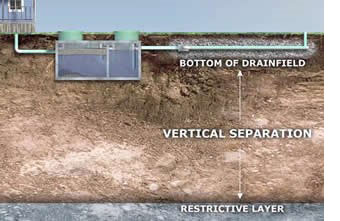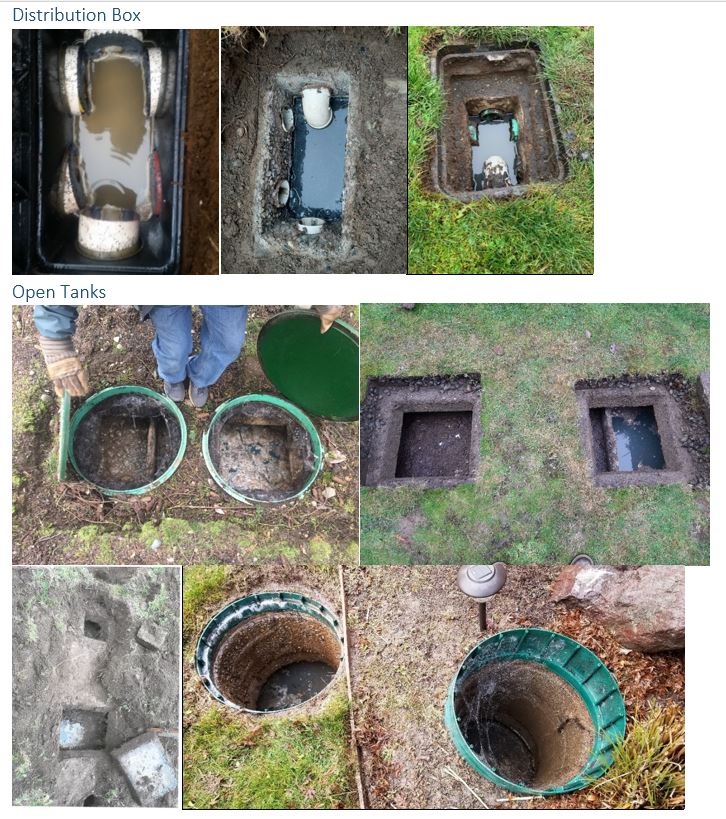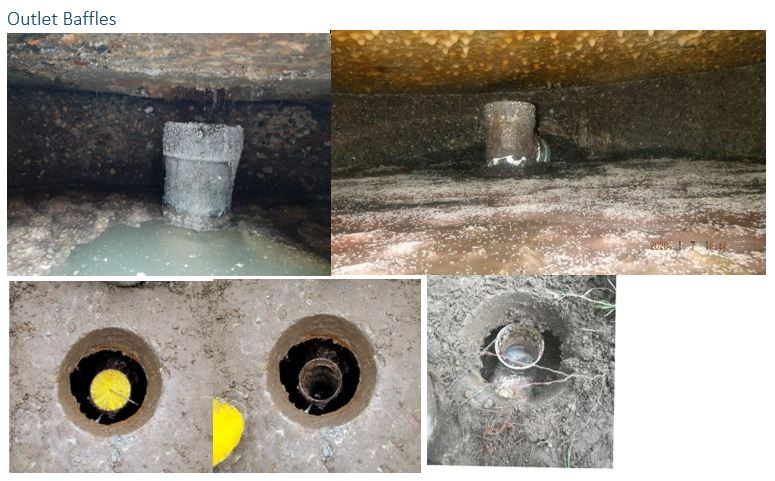Environmental Health
Skagit County Homeowner Septic Education Program |
||
Septics 101 |
||
|
||
Septics 201 |
||
ONLINE4TRAINING GUIDESkagit County’s Septics 201 Online Training program is designed to help property owners maintain and use their septic system, as well as conduct regular evaluations of their OSS. Regular evaluation of your On-Site Sewage System (OSS) is required by State (WAC 246-272A-0270) and local (SCC 12.05.160) health regulations. Properly operating and maintaining your system is required to ensure that our wastewater is not creating a source of pollution to local waterways or causing disease from contact with contaminated water. OSS evaluations must be performed and filed with the public health at least once every three years for all systems consisting solely of a septic tank and gravity drainfield, and annually for all other system types.
Once all the above conditions are met, homeowners may evaluate their own on-site sewage system (OSS). The homeowner is required to submit a completed On-Site Sewage Homeowner Inspection form, provided by public health. The completed form, submitted within 30 days of inspection, must include photos of:
An inspection report from a homeowner will only be accepted if the report is for that property owner’s OSS system. No other OSS may be inspected by the homeowner. Any exceptions to the above conditions must have written approval of Skagit County Environmental Public Health staff. Why Should I Inspect My Septic System?
Failing septic systems can leak into nearby ditches or streams where the sewage eventually ends up on our beaches where we swim, boat, and fish. Shellfish that grow in marine waters are harvested from our beaches and can become contaminated by failing septic systems. If shellfish filter polluted water, they can become unsafe for humans to eat. Flies, rats, and other vectors can encounter sewage from a failing septic system and subsequently pass the diseases found in sewage to humans or infect other animals at locations far from the failing system. When to Get HelpWhile the Septics 201 online program provides the basic information necessary to operate and maintain most gravity septic systems, it cannot address every condition and situation that may be encountered. An O&M Specialist is going to inspect operational components such as a flow test, a drawdown to verify that timer settings are correct, and a pressure test if applicable. It should be noted that at the time of a property transfer, a licensed O&M Specialist must conduct the inspection. Many older systems may vary in their configuration and construction. A system where there is no record drawing, no access, or if location is difficult to determine, may require a homeowner to hire a licensed O&M Specialist to assist them. In the past there were no standards for septic systems and permits were not required. There are a number of older homes where “something” was installed years ago that makes the wastewater “go away” but where it goes and how it functions is unknown. This does not mean that such a system is illegal or failed; it just means that a homeowner may have trouble conducting the evaluation. These cases may require the help of a licensed O&M Specialist. There may be circumstances where it will be difficult, dangerous, or even impossible for a homeowner to properly evaluate and maintain their OSS by themselves. In these cases, the owner will find it easier to utilize the services of a licensed O&M Specialist. For homeowners who conduct their own inspections, it is a good idea to hire a professional to conduct a septic system inspection at the time of system pumping. That way, they can perform any required maintenance while on site. |
||
Locating Records and Preparing to Inspect Your SystemThe first step in maintaining your septic system is obtaining your septic permit. Your septic permit will include an “as-built” or “record drawing”; this is a drawing that shows where your septic system is located and what parts or components make up your septic system. As-Builts or Record DrawingsAs-builts are drawings that oftentimes are drawn to scale or otherwise help describe the location of your septic system. Scaling, like on a map, allows you to find things accurately. The scale should be described on your as-built. The scale is typically depicted in inches to feet. For example, a scale of 1” = 20’ means that every inch on the paper is equal to 20 feet in your yard. If the as-built is accurate, this will allow you to find plumbing stubs, tank lids, distribution boxes, drainfield lines and observation ports. As-built drawings can be obtained at the Skagit County Online Septic Search If Public Health does not have a record for your septic system, it probably means that your system was installed a long time ago, prior to any requirement to create an as-built. It does not mean that you do not have a septic system or that it is failed or illegal. If there is no record drawing for your septic system you will need to contact a certified O&M Provider to request a record drawing be completed and submitted to public health along with their inspection. How to Find Septic System ComponentsGreen grass or depressions in your yard may be indications of where your tank is located. Oftentimes, when tanks are installed, the dirt used to cover them has a different texture than the surrounding area. Grass may grow greener in these disturbed areas. In addition, the dirt used to cover the tank will settle over time, creating a shallow depression. Probe suspected tank locations first, rather than digging up the soil only to find nothing. A long piece of rebar can be pounded into the ground to look for a tank. Simply take the rebar and pound it into the ground with a mallet. If you hear a hollow thud and the rebar stops going deeper, you may have found a tank. The probe can be used to identify the size and orientation of the tank (rectangle vs. round, 4’ X 8’ foot, etc). Lids will likely be located near both ends of the tank. The next step required to maintain your system is to dig up and remove your septic tank lids. You must be able to observe the inlet and outlet of your septic tank. Lids are heavy and may be difficult to remove. Tank lids come in different shapes and sizes. Lids may be square, round, or rectangular, and are typically large enough to allow for the tank to be pumped out. Some tanks have smaller lids on each end of the tank to allow for inspection of inlet and outlet baffles. Concrete lids may become cemented into place due to the shrinking and swelling of concrete. Oftentimes, the metal handle used to remove the lid may become rotted, and will not support the weight of the lid, nor be usable for “popping off” the lid. If you cannot remove the lid, contact a licensed O&M Specialist If you successfully locate your septic tank and remove its lids, the next step is to locate your drainfield. This will be located downhill from the septic tank outlet baffle (unless there is a pump). Your “as-built” or record drawing should describe the location of your drainfield. If you cannot locate your drainfield, please contact public health or a certified O&M provider for help finding your drainfield. See Department of Health Gravity Septic System inspection guide for a complete checklist and necessary tools. Reporting
Your form must be completed in its entirety. Missing information, photographs, etc. will be sent back to the homeowner for revision. Forms and photographs may be emailed to septic@co.skagit.wa.us or sent to 1800 Continental Place, Mount Vernon, WA 98273. Required PhotographsThere are 2-3 photographs required with every septic system report. The outlet baffle and pictures of the tanks with the lids open are required for all systems. If you have multiple tanks, we need multiple photos! If your system has a distribution box, that is also a required photograph. Below are some examples of inspection photos from recent reports that show how to capture system information with a few photographs. |
||
|
 |
One of the main site characteristics that determines the type of system you have is the depth of native, unsaturated soil beneath the drainfield and above a water table or other restrictive layer. This is called vertical separation, and you can see in the figure how the vertical separation determines the type of system needed for a specific site. |
Safety & General Hygiene
Evaluating, maintaining, or troubleshooting your septic system can expose you to the many pathogens or disease-causing organisms found in human waste. Hygienic practices mentioned here will help you protect yourself. Proper hygienic practices minimize the risk of exposure to disease causing agents that are found in sewage. It is up to you to use whatever techniques you feel necessary to adequately protect yourself from exposure to raw sewage, and to seek medical assistance if you are exposed. It is imperative that you take all necessary precautions to minimize the risk of becoming sick or injured when conducting your inspection.
If at any time you do not feel comfortable or confident in your ability to evaluate and maintain your septic system without the risk of becoming ill or injured, you should hire a licensed O&M Specialist to perform the work for you. Public health licenses these professionals, and maintains a list of System Maintenance Providers
Clothing
Protective clothing should be worn whenever you maintain your septic system. You may get splashed or sprayed with raw sewage. Covering the eyes, mouth, and any open cuts is particularly important. These areas provide a transmission corridor for viruses and bacteria to enter the body. Exposing these areas to sewage increases a person’s risk of contracting an illness.
Gloves are the first line of defense for the average do-it-yourselfer. Maintaining your system will require the use of your hands to do many things including lifting lids, operating sludge judges, lifting floats, pulling filters, and adjusting valves. Using gloves will minimize your exposure risk.
Face shields or goggles are recommended. They protect your eyes and mouth from the liquids in your septic system. Splashing or spraying can and will occur. Protecting your face, eyes, and mouth will minimize your risk of illness. After completing your inspection and necessary maintenance, you should shower or bathe, even if you don’t feel like you’ve been exposed to sewage. At a minimum, wash your hands using soap and hot water.
Tools
Tools can be used to further minimize your exposure to the sewage contained in your septic system. Rakes, shovels, and poles can be used to reach components that are well below ground or out of reach. Rakes can be used to lift floats and screens. Shovels can be used to evaluate the depth of the scum and sludge found in your septic tank.
A hose with a nozzle can be used to pre-clean risers, plumbing, and inspection ports. While trouble-shooting, water can be used to simulate normal water flow through the septic system.
Decontamination
Proper decontamination of equipment is an important task that will minimize your risk of becoming ill. While exposure to raw sewage is readily evident, exposure to residues from contaminated equipment or clothing may not be apparent yet can still result in illness. For this reason, equipment, clothing, and tools that have been splashed with or immersed in effluent or sewage, must be decontaminated. Care must be taken to properly clean electronic tools such as drills or screw drivers. Clean these tools in accordance with the manufacturer’s instructions.
Assemble the following items when decontaminating your equipment and tools:
- Garden Hose for rinsing equipment.
- 5 Gallon Buckets
- Soap or detergents
- Brush for cleaning grime and grit from tools with hard-to-reach places
- 5 Gallon bucket containing water with a good splash of bleach
- Plastic cup for rinsing large tools with the sanitizer
Decontamination of equipment or tools should include a four-step process. In the area near your drainfield, arrange products and tools where you can:
- Rinse: Start by rinsing the equipment and tools with water from your garden hose. Remove gross contamination from your equipment. This process may require the use of a stiff bristled brush to remove all contaminants.
- Wash: Next, immerse the equipment into the 5-gallon bucket containing a soap and water mixture. Use a brush to clean the hard-to-reach portions of the tools. Let the equipment soak as needed. Larger tools may require the use of a brush and a small rinse cup to completely clean areas that cannot be immersed in the bucket.
- Rinse: Spraying down portions of your septic system may result in exposure to sewage. Remove the equipment and tools from the soap and water mixture. Again, using the garden hose, rinse the soap from the equipment; this will ensure the soaps do not bind with the sanitizer.
- Sanitize: After thoroughly rinsing the tools, immerse the equipment in a sanitizer solution. Household bleach is a very effective sanitizer for killing bacteria and viruses. Use approximately 1 ½ cups of bleach per gallon of water (www.osha.gov) Other products, including peroxide sanitizers are effective too. Never mix sanitizers! Fully immerse the tools and equipment in the solution as much as you can, let stand for 3 minutes or longer.
Electricity
Septic systems that contain a pump also include an electrical element. A homeowner maintaining a pump system should minimize electrical hazards where appropriate. Any homeowner with a pump included in their system is required to obtain additional training with a certified Operations & Maintenance (O&M) provider to sign off on the additional training provided for these system types. Find a certified O&M provider
Electrical connections are typically buried and run underground from the dwelling to the pump tank. You may find junction boxes, wires, or other electrical connections in the pump chamber. Ideally these connections, when found in the pump tank, will be located in a junction box that keeps wire connections protected from breakage, while keeping the wires organized. Electrical connections should need very little maintenance if your pump controls and alarms are functioning as designed. If electrical problems are identified, a homeowner should contact a licensed Electrician. Check the Washington Department of Labor and Industries to find information about electricians.
Gases
Septic systems produce gases that can be explosive or are capable of displacing oxygen. For these reasons, a person should do everything possible to minimize risk of exposure to gas. Prior to using any electrical device (screwdrivers, drills, flashlights, etc.), all septic system parts should be vented thoroughly. A person should never, for any reason, enter the confines of a septic system, especially tanks.
Methane gas is produced by decomposition of organic materials. It is likely that methane will also be found in your septic system. A properly functioning septic system will allow for the proper venting of these gases, either through a dwelling’s plumbing system or through vent pipes located near your septic system.
Some gases found in properly functioning septic systems have different densities. These gases can sink or rise, displacing oxygen that you need to breathe. While leaning over the system, be sure to recognize that gases may have accumulated around where you are breathing. These gases can be odorless and may deprive you of oxygen.
 Operation and maintenance of your home septic system begins with your actions inside the home. What you flush, how much you flush, and how much water you run down the drain will affect the function and performance of your septic system.
Operation and maintenance of your home septic system begins with your actions inside the home. What you flush, how much you flush, and how much water you run down the drain will affect the function and performance of your septic system.
Water Use
Water usage is likely the biggest contributor to a failed septic system. Every drip, drop, sprinkle, or spray of water that goes down a shower, sink, toilet, or drain will end up being processed by your septic system. Reducing water use will limit the demand you place on your septic system. Faucets and toilets should be free of any leakage. Most people perceive a slow dripping faucet as nothing more than a nuisance; however, a septic system will be burdened by additional water going down the drain.
Install flow restrictors on all or select faucets. Flow restrictors are an easy and effective means to reduce water consumption. Flow restrictors on showers and other high volume water fixtures can dramatically reduce your consumption of water. Many flow restrictors have no mechanical parts while others reduce flow based upon pressure. They can be purchased at your local hardware store and are fairly easy to install in a typical faucet.
If you have a water meter on your property, you can easily figure out how much water you and your family are using. If your water meter has a counter, all you need to do is write the number down, along with the time and date and a few days later, look at the meter again. Subtract the smaller number from the larger; the difference is the amount of water you used since the previous time you read the meter. Figuring out how many gallons of water per day that you have consumed, will allow you to evaluate if your septic system is operating per the original design. Be aware that your meter readings may represent all of the water used, including irrigation. If you have been watering lawns and other landscaping on your property, your readings may not accurately reflect all of the water processed by your septic system.
Check Household Plumbing
Some plumbing (like toilets) can leak so slowly that it is difficult to hear or see signs of a leak. There are a number of things you can do to check for leaks.
One way that you can identify a very slow leak is by shutting all faucets off and keeping them off for a period of time. Read the meter once all faucets are off, and then wait a few hours and check the meter again. If the meter has moved, yet you have used no water during that time, you may have a very slow leak.
You can check for leaks in your toilet too. Open the lid to your toilet tank and pour enough food coloring into the tank water to color the water. If there is a slow leak, the food coloring will show up in the toilet bowl. This is a cheap and easy way of assessing your toilet for leaks, which may otherwise be difficult to detect visually.
Harsh Chemicals
Harsh chemicals including acids, bases, pesticides, herbicides, oils, paints, and varnishes should never be drained into any fixture that leads to your septic system. The chemicals can alter the natural biological conditions found in your septic system. Altering the biological balance may discourage the natural proliferation and growth of bacteria found in your system and will not allow for normal and productive decomposition of the wastes you put into your septic system.
Most household wastes, such as harsh chemicals, paints, and oils can be disposed of at your
Household Hazardous Waste Facility: 14104 Ovenell Road, Mount Vernon, WA 98273
There is a 25 gallon / household / month limit, for free! If the label says, “Danger”, “Warning” or “Caution” bring it to the facility for proper disposal.
Other Waste Products
Everything you put down your drain or into the toilet will end up in your septic system. Your septic system is not capable of handling many wastes that you may generate in your home. Cat litter, pet poop, condoms, tampons, sanitary napkins, disposable diapers, paper towels, facial tissue, hand wipes, hair, cigarette butts, and coffee grounds are only some of the items people flush into their septic systems but shouldn’t. Many of these products can clog your plumbing and septic system. These materials do not decompose or breakdown easily, if at all. Flushing them will increase the need to pump, maintain and repair your system.
Grease is a common household waste product that many people flush or rinse down the drain. Greases can congeal anywhere in your plumbing or septic system. Once these products congeal, they can cause blockages in your system. Materials that are flushed may get caught up on this congealed ooze and the blockage worsens. Grease can also clog the pores in your soil, damaging your drainfield and may lead to system failure. If still warm and in liquid form, the grease can be poured off easily into a water-tight container such as a coffee can and disposed of in the trash. Another way to dispose of grease is to let the grease cool in the pan, where it can be scraped off using a paper towel. The grease laden paper towel can then be disposed of in your trash.
Some household products are advertised as “septic safe”. While they may not have a negative effect on your system, they do fill your septic system with wastes that require removal through pumping. Additives and old “cures” such as using cabbage, hamburger, yeast, etc., have no beneficial effect on your septic system, but will lead to more frequent pumping of your septic system. Save your money from “septic tank additives”.
Garbage disposals are frequently installed in new homes. Using a garbage disposal on a septic system is not recommended. A garbage disposal adds more solid material to your septic system. In addition, some garbage disposals are capable of grinding or shredding material to a very fine size. These small bits of ground-up material are often difficult to settle out and these unsettled particles can pass through your septic tank, eventually damaging pumps or clogging the soil beneath your drainfield.
Proper care and maintenance of your septic system also occurs around the area where your system is installed. Many things you do in your yard or on your property can affect the system’s function and performance.
Drainage
Directing surface water away from your tanks and drainfield will help your drainfield function as well as possible. Water coming from roof drains, driveways or other surfaces should be directed away from your septic system. Remember, the soil where your drainfield is located, is capable of disposing of only so much liquid. Additional water, clean or not, taxes your soil’s ability to accept all of the liquids landing on the soil.
French drains, curtain drains, or shallow diversion ditches can help move water out and around your septic system. Septic systems that have a curtain drain installed around them, often are dependent on a functioning curtain drain. Curtain drains may require some maintenance themselves. Keeping drains free from blockage ensures that surface water is being moved properly around your septic system.
Landscaping
Landscaping in and around your septic system is important. Poor landscaping can cause septic system problems, including premature failure of your septic system. The rule of thumb for planting is to use only shallow-rooted plants such as grasses.
Local landscapers or nurseries can help you select plants that are appropriate for the areas around your septic system. Make sure the nursery understands you need plants that are shallow rooted and require little watering.
| Fill out the checklist form and return it to Public Health |
|---|




















 Routine inspections save time and money in the long run. A septic system is a huge property investment, so maintaining the one you’ve got is cheaper than replacing the entire system. Think of inspections like oil changes and routine maintenance for your car, you do a little here and there to keep it running for as long as possible. These inspections can identify small issues and fix them before they become big, costly repairs.
Routine inspections save time and money in the long run. A septic system is a huge property investment, so maintaining the one you’ve got is cheaper than replacing the entire system. Think of inspections like oil changes and routine maintenance for your car, you do a little here and there to keep it running for as long as possible. These inspections can identify small issues and fix them before they become big, costly repairs.  The final step to evaluating your system is completing the appropriate Skagit County Health Department On-Site Sewage System (OSS) Homeowner Report. There is one for gravity systems and a different form for pump/pressure systems:
The final step to evaluating your system is completing the appropriate Skagit County Health Department On-Site Sewage System (OSS) Homeowner Report. There is one for gravity systems and a different form for pump/pressure systems:
